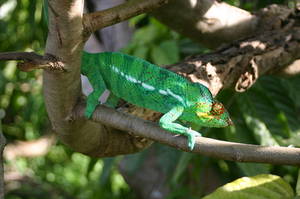Something that we all know about the natural world is how the colourful chameleons are masters of disguise changing the way they look to blend perfectly with their surroundings, hiding away from would-be predators that they are too slow to run away from.
 And we might expect that the need to camouflage themselves must have been the reason chameleons first evolved the ability to change colour.
And we might expect that the need to camouflage themselves must have been the reason chameleons first evolved the ability to change colour.
But now a new study from researchers Devi Stuart-Fox and Adnan Moussalli have come up with support for an alternative theory. It could be that chameleons adopted their colourful lifestyles not to blend in but instead to be as conspicuous as possible so they could communicate with each other, in particular for males to display their dominance over other males during disputes over female mates.
To test this idea, the team visited African rainforests where they conducted some bizarre experiments on African Dwarf chameleons - they set up a series of duels between competing males to see which one became the most flamboyantly coloured during battles for supremacy - the winner displays his victory with gaudy bright colours while the looser admits defeat, with dull drab colours. The researchers placed two different males on the same branch and waited until a fight was about to break out. They then measured the colours of the winning and loosing males using a gadget that determines the wavelengths of colour that bounces off an object (called reflectance spectrometry)
The researchers used the same technique to measure the colour of the surrounding vegetation where each species of chameleon is usually found. They then used data from earlier studies about the types of receptors in the eyes of both chameleons and their main predators, birds, to work out how conspicuous each chameleon would appear against the background of their normal habitat.
What they found was that the chameleon species showing the most dramatic colour changes were also putting on the most eye-catching displays for other chameleons, making themselves very obvious against the surrounding vegetation. They also found that of all the chameleons they studied, those that could change colours the most did not live in habitats that were particularly variable - so they probably weren't changing colour because they had to blend into a range of different backgrounds.
The researchers think that chameleons may have first evolved the ability to change colour to help them maintain their body temperature, and that subsequently some chameleons began to communicate to each other using bright, flashy colours.










Comments
Add a comment